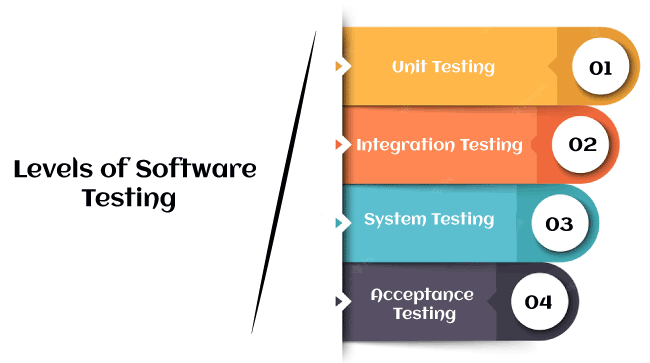Levels of Software Testing
As we have discussed earlier, testing is performed to enhance and measure the quality of software. In order to achieve the goal of a premium quality product, we have software testing principles. Similarly, software testing has different testing levels to ensure that the product is a defect-free product with high-quality standards.
Various testing levels help in reducing the repetition, overlapping, and missing areas between the multiple SDLC phases. It also helps in the preparation of test cases for each testing level to find the number of hidden bugs in the software as early as possible. Each testing level has a number of features and advantages that makes the testing process easier to execute and maintain. All the SDLC phases undergo the process of test levels to test the nature and behavior of the software at various SDLC phases.
Let us take a look at the various software testing levels. Generally, there are four software testing levels in software testing, as mentioned below:
- Unit/ Component Testing
- Integration Testing
- System Testing
- Acceptance Testing

Unit Testing or Component Testing
A unit or component is the smallest part of the application or software. The first and the most basic level of testing is Unit testing. It is performed on every individual unit or component of the software to check the functionality of each unit. Basically, it validates the performance and behavior (functional and non-functional) of each unit against the requirements specified in the document.
Software is made up of multiple units or modules; to test each module simply and efficiently, unit testing is performed. When unit testing is performed on a single module, error detection is much easier, cheaper, and consumes less time. It is usually performed by the developers.
Some of the advantages of Unit testing are:
- Unit testing is performed separately on each unit rather than on the whole software.
- It is cost-efficient and saves a lot of time.
- It is easy to detect and fix the errors of an individual unit.
- Unit testing is implemented by the developers in their local environments before the code is given to the QA team.
Integration Testing
Once the Unit testing is completed, the next level of testing performed is Integration testing. It is performed on the combination of two or more units /modules of the software to validate the interaction between them. In other words, testing the functionality of a group of similar or related modules is known as Integration testing. The main purpose of integration testing is to validate the performance, behavior, and flow of data from one component to another in order to test whether the combined components are working fine together or not. It helps to identify the errors/ faults that come in the process of merging two or more modules. It is usually performed by the testers.
There are mainly four ways to execute Integration testing, as mentioned below:
- Top-Down Integration Testing – In this type of Integration testing, the testing begins from the top or higher-level units to the bottom of lower-level units. Basically, the testing approach is to test modules from top to bottom.
- Bottom-Up Integration Testing – In this type of Integration testing, the testing begins from the lower-level units to higher-level units. Testers follow the approach of the bottom to top testing. It is the opposite of Top-Down Integration testing.
- Big-Bang Integration testing – In this type of Integration testing, components are tested all together in a single phase. To test small applications and software, this testing model is used.
- Hybrid/ Mixed Integration testing – This type of testing is also known as Sandwich integration testing. It is a mixture of both Top-Down and Bottom-Up testing approaches. Hybrid testing starts when all the modules are available.
System Testing
The third level of software testing is System testing. It is performed on the whole system when all the components are completed and integrated. System testing is also referred to as End-to-End testing as it tests the overall system, its components, and the interaction between those components. The main purpose of System testing is to thoroughly test and verify the functional and non-functional behavior of the system, and it should meet the specified quality standards. Through system testing, we can test and validate both the system architecture and business requirements.
System testing is categorized into two parts:
- Functional System testing: In this type of testing, testers validate and test all the functional requirements of the system.
- Non-Functional System testing: In this type of testing, testers validate and test all the non-functional requirements of the system. Performance, Load, Stress, and Usability testing are some examples of non-functional testing.
Acceptance Testing
Acceptance testing is the last level of software testing. It is also known as User Acceptance Testing (UAT). It is performed to validate and ensure that the system should meet the requirements specified in the requirement specification document before delivering it to the client. The main purpose of Acceptance testing is to provide the customer confidence in the System's quality and useability.
Acceptance testing is categorized into two parts:
- Alpha testing: The type of testing performed by the testing team to find and fix all the faults in the system prior to its release is called Alpha testing.
- Beta testing: The type of testing performed by the client or end-users to validate that the system is working as per the requirements prior to its release in the market. After the successful completion of alpha testing, Beta testing is performed in the real environment.